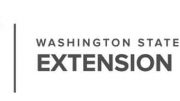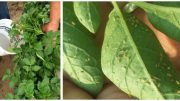|
Click to listen to this article
|
| This information was compiled by Carrie Wohleb, Washington State University (WSU) Extension, with input from Tim Waters, WSU Extension, and Mark Pavek, WSU Horticulture. |
| We have been getting a lot of questions about MH-30. The following information is intended to help you understand the possible uses of MH-30, and explain the application notes that are provided on product labels. |
| WHAT IS MH-30? Maleic hydrazide (commonly referred to as MH-30) is a plant growth regulator that acts by inhibiting cell division, but it does not stop the expansion of existing cells. Its primary use in potatoes is to control sprouting, but it may also improve tuber grade, reduce additional sets of tubers, reduce tuber shrinkage in storage, and reduce the number of volunteer potatoes the following spring. The companies that sell MH-30 are careful to note on the label that some of these effects may not always be seen. Effects of MH-30 can be quite variable and depend on many factors, especially the cultivar, application timing, crop and environmental conditions at the time of application, and application method. |
 |
| RUSSET BURBANK & MH-30: Many studies were conducted in the 1950’s to learn about the effects of MH-30 on potatoes. They used several cultivars in these trials, but Russet Burbank is the only one that is still grown on significant acreage. Trials with MH-30 are still conducted, and many of them continue to include R. Burbank as a standard. That means a lot is known about the effects of MH-30 on R. Burbank, and less is known about its effects on newer cultivars or those that are not as widely grown. That is probably why most MH-30 labels mention its effects on R. Burbank and are vague about its effects on other cultivars. |
 |
| APPLICATION TIMING & MH-30: MH-30 should not be applied until the smallest tubers that you want to harvest are at least 2 to 2.5 inches in diameter. Application before that time may result in phytotoxicity (usually a bronzing of leaves), and reduced tuber size and yield at harvest. Growers should be very careful not to apply MH-30 too early. It is important that enough cells have been produced that can expand into marketable-sized tubers before cell division is inhibited. Most studies show yield penalties with early application no matter what cultivar is grown. Some product representatives suggest as a “rule of thumb” that MH-30 should not be applied until at least 80% of the tubers are greater than 2.5 inches in diameter. |
 The 2 to 2.5 inch diameter minimum is intended for Russet Burbank (or similar cultivars) and is not meant for round cultivars like chippers or reds. They are also specific to potatoes grown west of the Rocky Mountains. If you grow round potatoes and are considering use of MH-30, then take a look at the label instructions for potatoes east of the Rockies for some guidance or contact your MH-30 product representative. The 2 to 2.5 inch diameter minimum is intended for Russet Burbank (or similar cultivars) and is not meant for round cultivars like chippers or reds. They are also specific to potatoes grown west of the Rocky Mountains. If you grow round potatoes and are considering use of MH-30, then take a look at the label instructions for potatoes east of the Rockies for some guidance or contact your MH-30 product representative. |
| CROP CONDITION & MH-30: MH-30 should be applied to healthy, green leaves for efficient uptake and translocation to the tubers. The label suggests applying MH-30 no later than two weeks prior to vine kill, but if the vines are significantly senesced at that time, then it may be too late for good sprout control and other benefits like volunteer potato suppression. It can be easy to miss this application window if you are growing a determinant cultivar like Russet Norkotah, that can quickly senesce when the weather turns hot. Indeterminant cultivars that keep growing for longer, like Russet Burbank, should be easier to time application. |
 |
| Applying MH-30 when potato plants are stressed can also reduce its performance and may have other negative effects. Stress (from heat, drought, or disease) results in poor uptake and distribution of MH-30 in the plant. The MH-30 labels are adamant that you DO NOT APPLY TO POTATO PLANTS UNDER STRESS. |
| ENVIRONMENTAL CONDITIONS & MH-30: Environmental conditions can have a big impact on MH-30 efficacy. If conditions are hot and dry, then the spray solution tends to dry (or crystalize) too quickly, and before maleic hydrazide can be absorbed by the leaves. In the Columbia Basin, it may be best to apply MH-30 in the evening, when temperatures are likely to be cooler and the sun is less intense. The label recommends applying MH-30 when temperatures are below 85 degrees F. Irrigation too soon after application can dilute MH-30, so the label suggests delaying irrigation for at least 24 hours after application. Delaying applications for rain is also mentioned on MH-30 labels, but that is one factor we don’t usually have to worry about in the Columbia Basin. |
| APPLICATION RATE & METHOD: Uneven or excessive application of MH-30 may result in reduced efficacy and defects like elephant hide or bud end cracking. Ground application is the preferred method of application, but aerial application is the most common method of application in the Columbia Basin. Do not chemigate. Spray deposition of MH-30 is improved by using high water volumes for application (30 gallons per acre for ground application, 10 gallons per acre or more for aerial application), because it maximizes coverage and slows the drying time. Do not use spray adjuvants or tank mix with other products. |
 There are several notes on the label about aerial application height. Low applications (less than 12 feet above the crop) can result in uneven application and some excessive buildup of chemical (from overlap) that puts the crop at risk for costly defects. Conversely, applications too high above the crop can expose droplets to wind and evaporation. There are several notes on the label about aerial application height. Low applications (less than 12 feet above the crop) can result in uneven application and some excessive buildup of chemical (from overlap) that puts the crop at risk for costly defects. Conversely, applications too high above the crop can expose droplets to wind and evaporation. |
| REDUCING SECONDARY GROWTH: Second growth and misshapen tubers can result from renewed plant and tuber growth following periods of stress (heat waves or drought) that slow or stop plant growth. MH-30 has been known to reduce these effects, particularly in Russet Burbank. Russet Burbank is more prone to misshapen tubers compared to many other russet cultivars, which may explain why it often benefits from the MH-30 applications when other cultivars do not. For best results, MH-30 needs to have been applied before stress events to inhibit second growth. It has been suggested that MH-30 can reduce second growth when it is applied about 2-3 days after a stress event and when normal growth has resumed, but satisfactory results probably depend on factors like the subsequent growth rate of tubers. The heat sprouts, chain tubers, or knobs that started expanding before MH-30 application will not suddenly go away. |
 |
| RESULTS ARE NOT ALWAYS SATISFACTORY: In 2018 and 2019, M. Pavek, C. Thurgood, and Z. Holden (Washington State University) studied the effects of MH-30 applied to seven cultivars in the Columbia Basin. They applied MH-30 at the 1 gal per acre rate when there were about 7-9 tubers per plant greater than 2 to 2.5 inches in diameter. They did not observe a reduction in undersized tubers (<4 oz) for any cultivars. In 2019, MH-30 improved marketable yield and adjusted gross return for Russet Burbank due to a reduction in second growth (knobs), but this was not observed in 2018. MH-30 treatment did not affect marketable yield or adjusted gross return for Ranger Russet. But it significantly reduced marketable yields and adjusted gross returns for Russet Norkotah, Payette Russet, Alturas, Clearwater Russet, and Umatilla Russet. Cultivar differences can be significant and must be considered carefully. |
| MH-30 PRODUCT LABELS: There are two MH-30 products currently (August, 2021) registered for use on potatoes in Washington. Electronic copies of the labels can be accessed from the WSU PICOL Database (these are for informational purposes only): Royal MH-30 Xtra and Sprout-Stop. DISCLAIMER: It is a violation of Federal law to use MH-30 products in a manner inconsistent with their labeling. It is your responsibility to check the label before using any product to ensure lawful use, and obtain all necessary permits in advance. |






